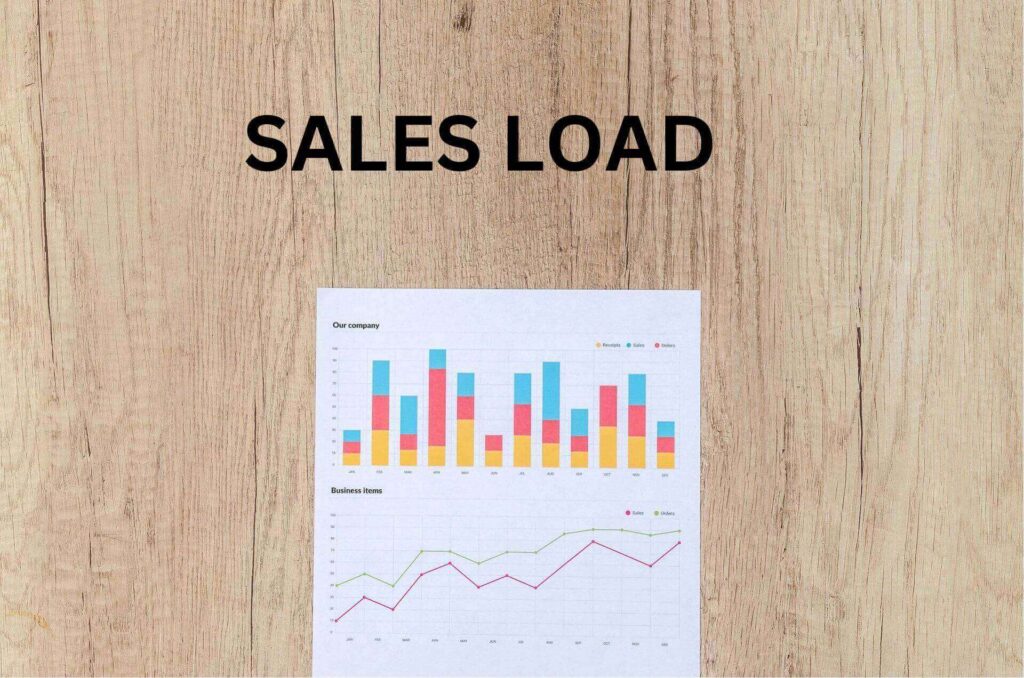
Sales load, also known as a “load fee,” is a type of sales charge that mutual fund companies may impose on investors when they buy or sell mutual fund shares. It is typically expressed as a percentage of the amount invested or redeemed, deducted from the total amount before they make the investment or the redemption proceeds are paid out.
The amount you pay for the load fee varies from one fund to another, depending on the share class. Charges are percentages of paying fees on a mutual fund prospectus. You’ll see a 5% or 3% sales charge depending on the desired fund.
They differ from other funds’ costs expressed in the expense ratio, which is calculated in a percentage formula and paid for by the fund. In contrast, sales loads are paid to the entity you purchase the fund from. The sales load and the expense ratio each have a separate charge. For instance, you may pay a mutual fund a 5% sales load and a 1% expense ratio.
Types of Sales Load
There are different sales load charges when buying and selling mutual funds. These fees vary from time to time. Below are the types of sales loads:
Front-end Sales Load
It is associated with A-share. They charge it when you buy mutual fund shares. It is deducted from the initial investment, and the remaining amount is used to purchase the fund’s shares. The maximum sales charge of a front-end load is 5.75%.
For example, if you invest $10,000 in a mutual fund with a front-end load of 5%, they deduct $500 and invest $9,500 in the fund.
A-share with front-end loads tends to pay a lower expense ratio than other pay shares. The expenses here are marketing and yearly management fees. In contrast, A-share with no load fund has a yearly maintenance fee as per the client’s amount so that the client may pay more.
Other operating expenses included as the load is the distribution services fee. A portion of the fund includes 12b-1fee (level load). The mutual fund pays the intermediary yearly as a per cent of a share class’s assets in quotes.
Back-end Sales Load
It is associated with B-share or C-Share. It is charged when you sell shares of a mutual fund. It is deducted from the redemption proceeds, which is the amount you receive when you sell your shares.
The back-end load may vary depending on how long you hold the shares, usually between 5 to 10 years. For example, if you sell your shares within the first year of purchase, the back-end load (deferred sales load) may be higher, but if you hold the shares for a longer period, it may decrease or even be eliminated.
It’s important to note that not all mutual funds charge fees. Some mutual funds, known as “no-load mutual funds,” do not charge any sales load on investors. However, even no-load funds may charge other fees, such as management fees and administrative expenses, which can affect your overall investment returns.
How Do Sales Load Work?

Sales load is typically used to compensate financial professionals, such as brokers or financial advisors, for their services in recommending and selling mutual funds to investors.
When you buy a mutual fund with a front-end load, you pay the fee to the financial professional as a commission upfront. When you sell a mutual fund with a back-end load, the sales load is also paid to the financial professional as a commission, which is deducted from the redemption proceeds.
According to FINRA, If both the acquiring and acquired companies have an asset-based sales charge:
- The maximum aggregate asset-based sales charge imposed by the acquiring company, the acquired company, and those companies in combination shall not exceed the rate provided in paragraphs (d)(2)(E)(i); and
- The maximum aggregate front-end or deferred sales charges shall not exceed 7.25% of the amount invested, or 6.25% if either company pays a service fee.
The fund charges both back-end and front-end loads. So, the sales charge formula to compute the sales charge plus what to pay to invest must include the following:
- What was paid initially per share?
- Initial total amount invested
- Back-end load or front-end load
- The net asset value of each fund share
Here’s an example to illustrate how sales load works:
Suppose you invest $10,000 in a mutual fund with a front-end load of 5%. The mutual fund company deducts $500 (5% of $10,000) as the sales load, and the remaining $9,500 is used to purchase the fund’s shares. If the mutual fund’s net asset value (NAV) per share is $10, you will receive 950 shares ($9,500 divided by $10) in your account.
Now, let’s say you decide to sell your shares after one year. If the mutual fund has a back-end load of 5% for shares held for one year, the load fund would be $475 (5% of $9,500) deducted from the redemption proceeds. So, if you sell your shares after one year, you would receive $9,025 ($9,500 minus $475) as the redemption proceeds.
According to FINRA, If both the acquiring and acquired companies have an asset-based sales charge:
- The maximum aggregate asset-based sales charge imposed by the acquiring company, the acquired company, and those companies in combination shall not exceed the rate provided in paragraphs (d)(2)(E)(i); and
- The maximum aggregate front-end or deferred sales charges shall not exceed 7.25% of the amount invested or 6.25% if either company pays a service fee.
The fund charge both back-end and front-end loads. So, the sales charge formula to compute the sales charge plus what to pay to invest must include the following:
- What was paid initially per share
- Initial total amount invested
- Back-end load or front-end load
- The net asset value of each fund share
Here’s an example to illustrate how sales load works:
Suppose you invest $10,000 in a mutual fund with a front-end load of 5%. The mutual fund company deducts $500 (5% of $10,000) as the sales load, and the remaining $9,500 is used to purchase the fund’s shares. If the mutual fund’s net asset value (NAV) per share is $10, you will receive 950 shares ($9,500 divided by $10) in your account.
Now, let’s say you decide to sell your shares after one year. If the mutual fund has a back-end load of 5% for shares held for one year, the load fund would be $475 (5% of $9,500) deducted from the redemption proceeds. So, if you sell your shares after one year, you would receive $9,025 ($9,500 minus $475) as the redemption proceeds.
No-Load Funds
There are alternatives to avoiding paying a load fee by selecting a no-load fund. The no-load fund does not charge fees or commissions to any back-end or front-end fund. But you must pay redemption fees of 2% for short-term trades. There are also account maintenance fees, exchange fees, and purchase fees. In addition, the no-load fund charges an expense ratio.
By contrast, no-load share classes—those with neither a front-end nor a back-end load fee and a 12b‑1 fee of no more than 0.25 per cent—generally have seen net inflows and rising net assets since 2010. As a result, the percentage of long-term mutual fund total net assets held in no-load share classes rose from 56 per cent at the year-end of 2010 to 73 per cent at the year-end of 2021.
Is Sales Load Worth Worth It?

Whether the sales load is worth it depends on various factors, including your investment goals, risk tolerance, and investment timeframe. Here are some considerations to keep in mind when evaluating its value:
A load fee is intended to compensate financial professionals for their services in recommending and selling mutual funds. If you value the advice and guidance of a financial professional and believe it can help you make better investment decisions, then paying a sales load may be justified.
1. Financial Professional Services
However, it’s essential to evaluate the credentials and expertise of the financial professional to ensure they are providing value that justifies the charge fee.
2. Investment Returns
Sales load can eat into your investment returns, as it is deducted from the amount invested or redeemed.
If you’re looking for the highest possible returns on your investment, a sales load may reduce your overall returns, especially in the short term.
However, it’s essential to consider the mutual fund’s potential long-term returns and the other associated fees when evaluating the impact of sales charges on your investment performance.
3. Alternative Options
Not all mutual funds charge sales loads. Many no-load funds are available in the market that do not impose sales loads on investors.
These funds may have lower fees, translating into higher net returns for investors. Therefore, it’s worth considering alternative options, such as no-load funds, when evaluating the value of the sales load.
4. Investment Timeframe
Sales load may be more justifiable for long-term investors who plan to hold their mutual fund investments for an extended period.
As mentioned, back-end loads may decrease or even be eliminated for shares held longer.
Therefore, if you have a long investment horizon, you may minimise the impact of sales loads on your overall returns.
5. Personal Preference
Whether the sales load is worth it is also a personal preference. Some investors may value the convenience of working with a financial professional and be willing to pay a sales load for their services.
Others may prefer a DIY approach and opt for no-load funds or other investment options with lower fees. It’s essential to consider your investment style and preferences when evaluating the value of the sales load.
Bottom Line
Sales load is a fee mutual funds charge to compensate financial professionals for their services in recommending and selling mutual funds. It impacts the overall returns of your investment, as it is deducted from the amount invested or redeemed.
It also depends on various factors, including investment goals, risk tolerance, an investment timeframe, and personal preferences. Reviewing a mutual fund’s prospectus is important before making an investment decision.
